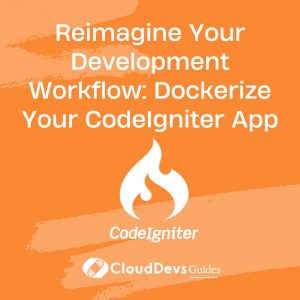Reimagine Your Development Workflow: Dockerize Your CodeIgniter App
In today’s fast-paced software development environment, developers and organizations are constantly looking for ways to streamline the development and deployment process. Two technologies that have gained significant traction in this regard are CodeIgniter, a powerful PHP framework, and Docker, a platform for containerizing applications.
In this blog post, we’ll delve into the process of containerizing a CodeIgniter application using Docker, and you’ll learn:
– The basics of Docker and why it’s important
– Steps to containerize your CodeIgniter application
– A few example configurations for a seamless setup
1. Why Use Docker with CodeIgniter?
Before we dive into the nitty-gritty, it’s essential to understand why one might want to containerize a CodeIgniter application using Docker.
– Isolation: Docker containers encapsulate all the dependencies an application needs to run. This ensures that it will work consistently across different environments, eliminating the infamous “it works on my machine” syndrome.
– Scalability: Docker containers can be easily scaled up or down, making it easier to manage web traffic spikes or lulls.
– Portability: A Docker container can run on any system that supports Docker, making migrations or scaling across different servers or cloud providers straightforward.
2. Containerizing Your CodeIgniter Application: Step-by-Step
Let’s break down the process:
- Set Up Docker
Before you can containerize anything, ensure Docker is installed on your system. If not, follow the installation guidelines on the [official Docker website](https://www.docker.com/).
- Create a Dockerfile
Navigate to the root directory of your CodeIgniter application and create a file named `Dockerfile`. This file will contain instructions to Docker on how to build an image of your application.
A simple example might look like this:
```Dockerfile # Use the official PHP image from Docker Hub FROM php:7.4-apache # Copy CodeIgniter application into the container COPY . /var/www/html/ # Enable Apache mod_rewrite for CodeIgniter's .htaccess file RUN a2enmod rewrite && service apache2 restart # Install any PHP extensions (if necessary) RUN docker-php-ext-install mysqli # Expose port 80 EXPOSE 80 ```
This Dockerfile does the following:
– Use the PHP 7.4 image with Apache.
– Copy the CodeIgniter application into the default directory Apache serves from.
– Enable `mod_rewrite` for pretty URLs in CodeIgniter.
– Install the mysqli PHP extension (for MySQL database interactions).
– Expose port 80 so that we can access our application.
- Create a docker-compose.yml File (Optional)
For a more robust setup, especially when dealing with databases or other services, using Docker Compose can simplify the process. In the root directory of your CodeIgniter application, create a `docker-compose.yml` file.
```yml
version: '3'
services:
web:
build: .
ports:
- "80:80"
db:
image: mysql:5.7
environment:
MYSQL_ROOT_PASSWORD: rootpassword
MYSQL_DATABASE: codeigniter_db
MYSQL_USER: user
MYSQL_PASSWORD: password
```
This setup defines two services:
– The `web` service, which builds the Docker image using the Dockerfile from the previous step.
– The `db` service, which pulls a MySQL 5.7 image and sets up a database for your CodeIgniter application.
- Build and Run
With everything set up, navigate to the directory containing your Dockerfile and run:
``` docker build -t codeigniter_app . ```
This builds a Docker image named `codeigniter_app`. If you’re using Docker Compose, you can start your application with:
``` docker-compose up ```
- Access Your Application
Open your web browser and go to `http://localhost`. Voilà! Your containerized CodeIgniter application should be up and running.
Conclusion
Docker and CodeIgniter together make a powerful combination for developing and deploying web applications. With Docker, you can ensure consistency, scalability, and portability for your CodeIgniter applications. By following the steps and examples provided, you’ll be well on your way to leveraging the benefits of both technologies. Happy coding!
Table of Contents









